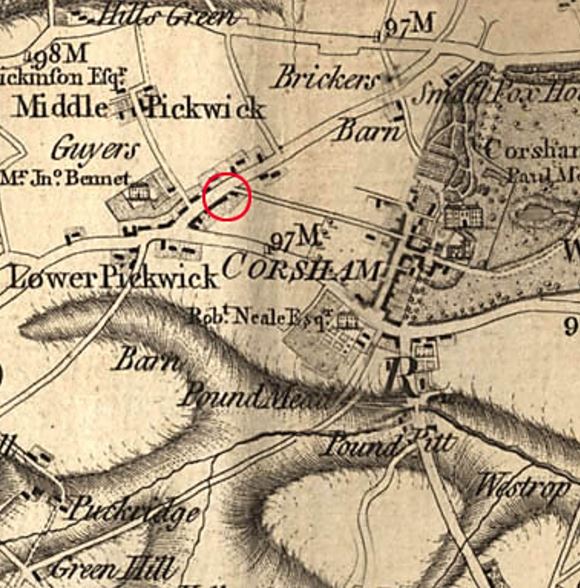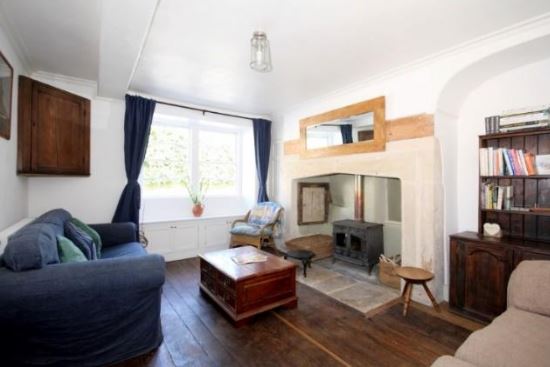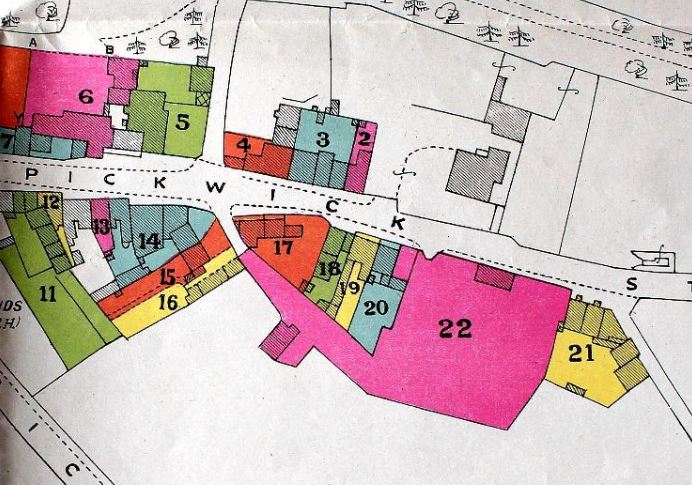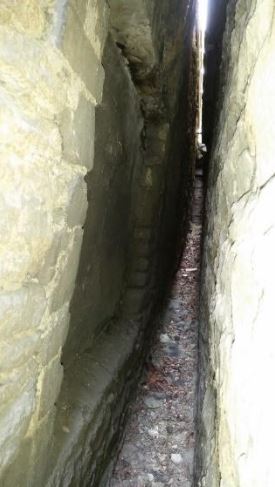Introduction
I should start by making clear that ‘young’ in this context actually means ‘newcomers’ to Pickwick. My wife, Cath, and I moved to 12 Pickwick at the end of January 2015. We had previously lived for nearly 40 years in Herne Hill, South London. Having recently retired, we moved to the area to be near our daughter, Anna, and family who live in Chippenham.
We have spent our careers in archaeology, both at Museum of London: Cath for 40 years, latterly in its Archaeological Archive Research Centre, and myself for 19 years, latterly as Principal Excavations Officer, City of London. We were involved in major archaeological excavations and published books and articles about the results. In 1989, I was made a Freeman of the City of London for “services to the archaeology of the City of London”. I also worked as Deputy Project Director, Stonehenge New Visitor Centre project for English Heritage (2001-2005), a version of which opened in 2013. Recently, Cath was presented with the Ralph Merrifield Award 2015 by the London and Middlesex Archaeological Society for long service to London’s Archaeology.
Background and History
When Cath and I were staying in Chippenham, looking for a new home in North Wiltshire, the owner of the rather listed B&B house in which we stayed showed us a history of the house researched by Ellen Leslie. We were very impressed with the contents, writing, images and excellent layout of Ellen’s research report and so when we bought our house in Corsham it quickly occurred to us to contact her and commission a history: the details that follow are taken from that report.
![Nos 12 & 14 Pickwick [2015]](https://www.corshamcivicsociety.co.uk/wp-content/uploads/2016/07/12-14-pickwick.jpg)
Nos 12 & 14 Pickwick [2015]
Although now part of Corsham, Pickwick was once a separate settlement. The name derives from Anglo-Saxon pic (meaning a peak or pointed hill) and wic (village). The Wiltshire Hundred Roll of 1273 refers to a “William de Pikewicke”. Pickwick is located on the north-west boundary of Corsham, on the A4, traditionally known as The Bath Road. Historically it was the direct route from London to Bath since Roman times. In the 17th century the rural areas around Chippenham, including Pickwick and Corsham became popular locations for dissenters or non-conformist sects and denominations; none more so than the Society of Friends, otherwise known as Quakers. In the early 18th century Quakers began to settle in Pickwick and remained an important part of the community for several centuries. It is the Quaker link that played an important part in the history of 12 Pickwick as well.

The 1773 Drury Map is the earliest known to show the existence of 12 Pickwick within the red circle although the individual buildings cannot be discerned.
The history of the area has many family threads that are woven into the fabric of Pickwick life, going back centuries; families such as the Mitchells, Hulberts and Goldneys. These families can be found in the area in the 17th century and later. Pickwick and the general Corsham area were places where families set down well-established roots. Research found the Mitchell (Michell) family, who were Quakers, were involved in many aspects of local life over several generations. Another example was the Goldney family. Records show this Quaker family being part of Pickwick life in the mid-19th century, living at Beechfield House. However, in 1918 Frederick Goldney bought the Pickwick estate from the Dickson-Poynder family, who were not Quakers. This estate remained in their possession, including 12 and 14 Pickwick, for another 30 years.
Another local family, with even deeper roots than the Goldneys or Mitchells, was the Hulbert family. Their most successful role in the life of the community was establishing the brewery at Pickwick; next to 12 Pickwick. The Pickwick Brewery was established in 1804 by William and Robert Hulbert. In 1841 the business and the copyhold was put up for sale. However, the Hulberts retained ownership of the business in the end, until nearly the 1860s. Sir John Dickson-Poynder bought the freehold of the Brewery in the 1850s when his family purchased the Hartham Estate.
In 1865 Thomas Hulbert went into business with Henry Padbury Manning at the brewery and in 1870. Local man Isaac Belcher bought the business and in 1875 he formed a partnership with Samuel Hale Smith. Twelve years later the partnership was dissolved. By 1889 Thomas Pearson Stevens ran the Pickwick Brewery. In 1909 the premises were leased by the Dickson-Poynder Estate to Wilkins Bros & Hudson Ltd, originally of Bradford-on-Avon. Having acquired the lease the new brewery owners set about modernising the place and in 1910 advertised the old plant for sale. Wilkins Bros. & Hudson Ltd were later bought by Ushers Wiltshire Brewery Ltd in 1919. The business in Pickwick closed in the 1920s and there ended over 100 years of the Pickwick Brewery. 12 Pickwick was connected to the brewery from about 1871 to the 1920s.
By the 1950s, the brewery yard was occupied by E S Cole and Partners as a storage and scrap metal business. However, the daily activities of the business were considered a nuisance to the community, particularly as the entrance to the yard next to 12 Pickwick was too narrow for large vehicles to access. As a result, another access point was used around the back of 12-20 Pickwick. Records show that this access proved to be an equal nuisance. As a result, it was agreed in 1953 between E S Cole & Partners and the Calne and Chippenham District Council to demolish part of the old malthouse between 12 Pickwick and the brewery yard to provide wider main road access to the lot. Later the Brewery site was a boat building works and today, renamed Lancefield Place, is a mixed use site for residential and small businesses.
Identifying 12 Pickwick in historical documents proved challenging as the earliest identified use of the house number is the 1948 sale by the Goldney Estate. Prior to that, it appears to have had neither formal name nor number. Therefore, it has been Tithe maps – in particular, those of 1756 and 1822 – and the accompanying records, as well as the census returns that have enabled the house to be tracked in time and the occupants of the house identified.
One key finding of 12 Pickwick is that while its history does overlap for a number of years with the neighbouring Pickwick Brewery, 12 Pickwick was not constructed as part of the adjacent brewery business. Evidentially, 12 Pickwick was constructed prior to the mid-18th century. A paper trail of documentary evidence from the tithe records reveals 12 and 14 Pickwick were already built by 1756. In that year the property was owned by Edward Michell (Mitchell) a Quaker, sometime Elder of that Society and a Coroner of Corsham as well. It is not known if he lived in 12 Pickwick but he was certainly the owner. By 1800 the property was owned by Sarah Mitchell and after her death in 1806 Susannah Mitchell owned the freehold on the building. It is likely that these women were close relatives of Edward Mitchell. While it was not unheard of for women to inherit and hold property in their own right in this period, the Quaker approach to equality between the sexes seems to have been the case here.
By examining tithe maps, awards and other related documents it is known that Dr Rev William Rance Sainsbury was a tenant at 12 Pickwick from the early 1800s until his death there in 1849. Rev Sainsbury, a ‘Man of the Cloth’, was a very long-standing and popular member of the Pickwick community. Records show that in 1832 Rev Timothy Conyers, who lived at Guyers House in Pickwick until his death in 1850, held the freehold of the property. In his lifetime he was also a friend of Rev Sainsbury as well as a witness to his will.
Rev Sainsbury was not a wealthy man and the will reveals another local friend, Gabriel Goldney, a Quaker, and future owner of Pickwick, had lent Rev Sainsbury certain amounts of money. It is not known how much, but enough that virtually all of his estate was left to Goldney to settle the debt, except for a total of £15 being left to three female servants and provision to his sister. According to Rev Sainsbury’s will he was The Clerk of Corsham. He also appears to have been a very popular man, with his death announced in favourable words.

Fig 14: Bristol Times and Mirror 14th April 1849
By the time of the census of 1851, 12 Pickwick was lived in by Ann Merrett, a woman living on her own means. Nothing more is known about her. The 1861 Census does not provide any clues as to the occupants of 12 Pickwick, however by 1871 it is possible to discern that it was lived in by Henry Kinnier, a commercial traveller and employee of the brewery. He was 49 in 1871 and he lived at 12 Pickwick with his wife Elizabeth (42) and their four daughters Fanny (22) Bessie (20) Kate (15) and Susan (13).
![1886 Ordnance Survey 1st Edition, the first Ordnance Survey map and in colour. This map shows the development of the Pickwick Brewery to the east of 12 Pickwick. The house is shown in bright red and the kitchen block [also in bright red] is clearly separate from the malthouse building.](https://www.corshamcivicsociety.co.uk/wp-content/uploads/2016/07/ordnance-survey-pickwick.jpg)
1886 Ordnance Survey 1st Edition, the first Ordnance Survey map and in colour. This map shows the development of the Pickwick Brewery to the east of 12 Pickwick. The house is shown in bright red and the kitchen block [also in bright red] is clearly separate from the malthouse building.
In 1918 the Pickwick Estate, including 12 Pickwick, was owned by Frederick Hastings Goldney until the sale of the property in 1948, when Frederick John Smith the long-standing tenant of the house bought the property from the Goldney Estate for £450. It is believed the Smith family remained at the property for several decades after.
The house
12 Pickwick, as one of a pair with 14 Pickwick is a Grade II early-mid 18th century house built to a high standard in rubble stone with quoin dressings and stone slate roof. It is constructed in two hipped roof ranges, front and back. It has the classic Georgian layout of a terraced house, namely an entrance and right hand passage running beside a front parlour and another smaller parlour to the rear. There is also a small cellar. The staircase winds up to a first and finally an attic floor on the right side of the build. Both the second and attic floors have one single large room across the width of the building at the front and a second smaller room on the left side of the building to the rear. Prior to 2010 there was a collection of rough outbuildings to the rear, as well as a much older separate construction, which is now used as the kitchen.
![The kitchen block which appears to have been part of a 17th century structure [see 1886 map above]](https://www.corshamcivicsociety.co.uk/wp-content/uploads/2016/07/kitchen.jpg)
The kitchen block which appears to have been part of a 17th century structure [see 1886 map above]

The front parlour with unblocked inglenook

Hall arch and well- proportioned staircase
Although 12 Pickwick was not constructed as part of the adjacent old brewery, it was linked to the brewery over several decades from later in the 19th century until the 1920s. There was once a malthouse next to 12 Pickwick, on the east side. Part of its east wall can still be seen running up to the Bath Road frontage. It was partially demolished in the 1953 when the scrap business E S Cole & Partners required a larger entrance to the site for large vehicles.
![1839 Tithe Map [the Malthouse and Nos 12 & 14 are ringed in red]. The kitchen block is discernible as a separate structure and the large Pickwick Brewery building complex is located to the south east of 12 Pickwick. The structure to the north of the kitchen block was demolished in 1953.](https://www.corshamcivicsociety.co.uk/wp-content/uploads/2016/07/1839-tythe-map.jpg)
1839 Tithe Map [the Malthouse and Nos 12 & 14 are ringed in red]. The kitchen block is discernible as a separate structure and the large Pickwick Brewery building complex is located to the south east of 12 Pickwick. The structure to the north of the kitchen block was demolished in 1953.

The 1947 Map of Pickwick for the Goldney Sale. The 12 Pickwick lot is numbered 20. The structure to the right of the house at the back is the kitchen block and the area in red above is the adjoining malthouse building demolished in 1953

The blocked up window in the west wall of the former malthouse
Both 12 Pickwick and The Pickwick Brewery premises came under the joint ownership of the Dickson-Poynder family in the mid-1850s when they purchased parts of the Conyers Estate and would have remained so until 1918 when Frederick Hastings Goldney bought the Pickwick property. Therefore, in the years when 12 Pickwick and the brewery were linked through tenancy, the kitchen block would have joined No 12 as part of one property, sold as one unit and remains so today.
The historical significance of 12 and 14 Pickwick was officially recognised in December 1960 when these semi-detached buildings were given a statutory listing with a group value of Grade II. This would have helped support a preservation order placed by Calne & Chippenham Rural District Council in 1963 to prevent the owner of 14 Pickford from replacing the ground floor windows. This was confirmed and supported by the Ministry of Housing and Local Government early the following year. In their letter they state that 12 and 14 Pickwick are of “special architectural and historic interest”.
12 Pickwick is a fascinating early to mid-18th century house originally built to a high standard which has enabled it to survive through to today. Similar houses nearby have date inscriptions of 1708, 1739 and 1745. The renovations carried out in 2011 achieved an appropriate balance of creating a modern home for 21st century living without losing the special historical features of the building.
A copy of History of The History 12 Pickwick in the Springfield Centre library.
John Maloney will become editor of Spotlight later this summer.